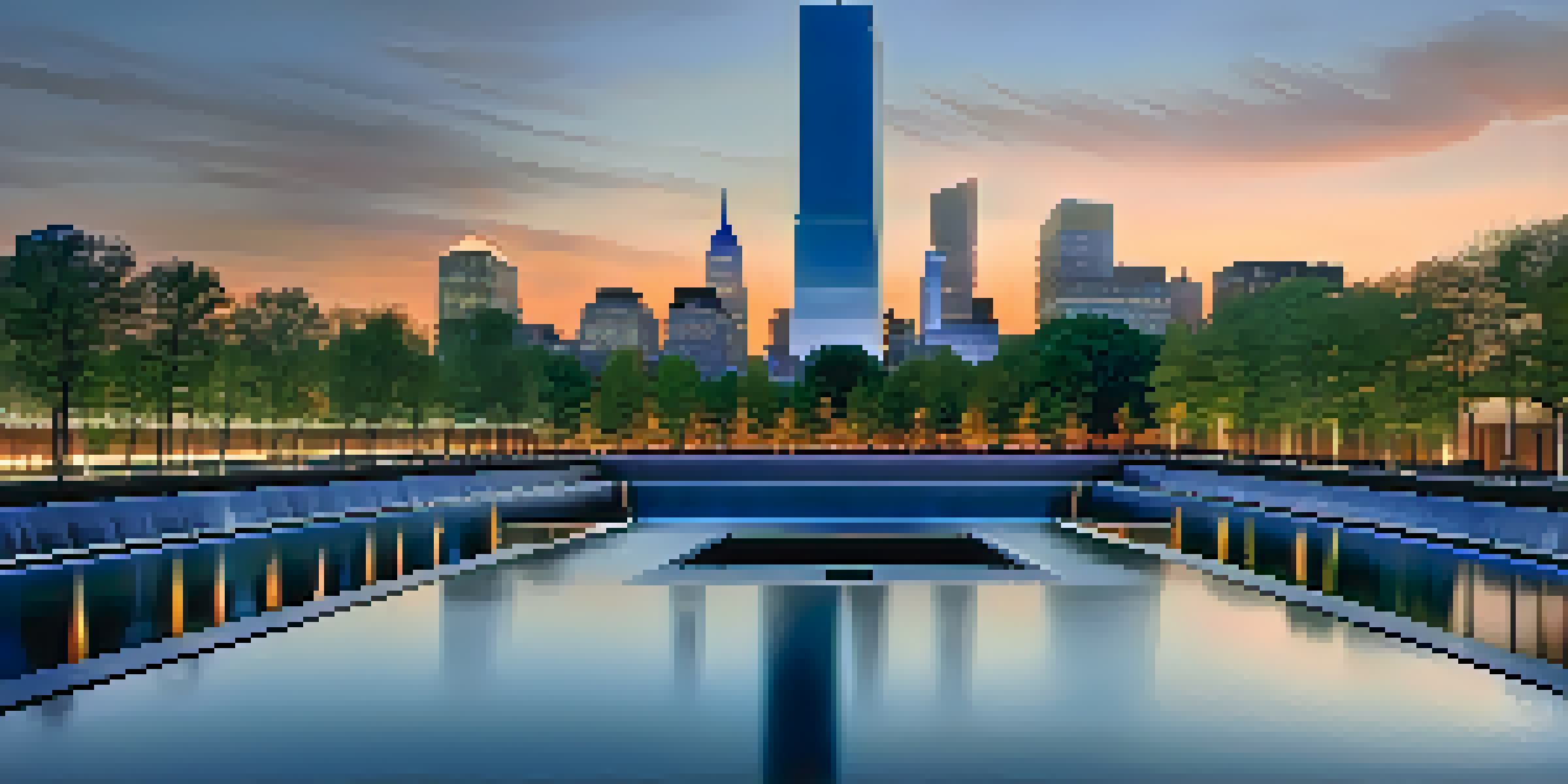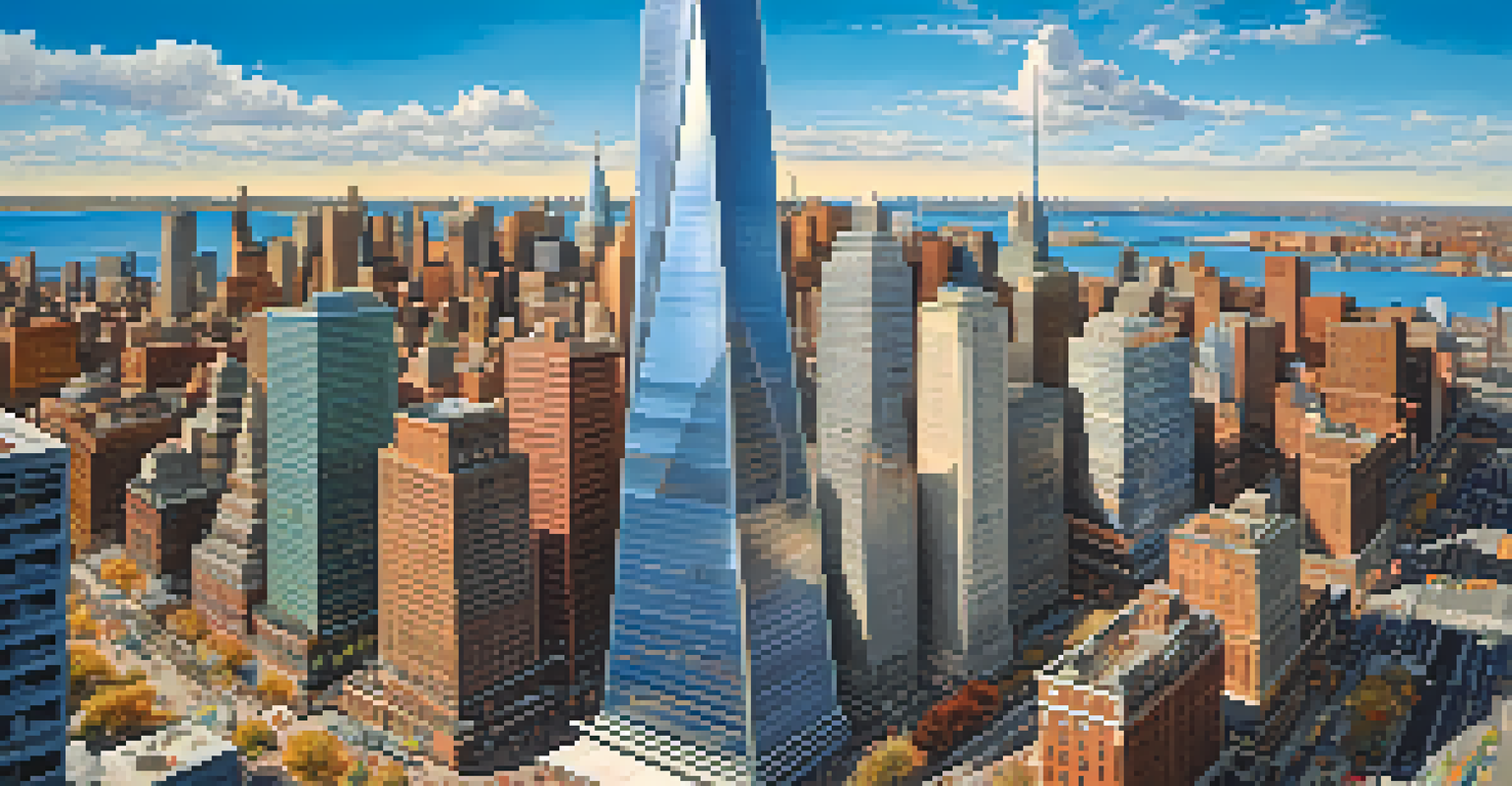The 9/11 Attacks: A Defining Moment in NYC's History

The Events of September 11, 2001: A Day of Terror
On September 11, 2001, the world watched in horror as terrorists hijacked four airplanes, crashing two into the Twin Towers of the World Trade Center in New York City. The attacks resulted in the collapse of both towers, leading to an unimaginable loss of life and a deep sense of vulnerability among Americans. In just a few hours, the skyline of New York was forever altered, symbolizing not only a physical attack but a strike at the heart of American values.
In the face of impossible odds, people who love this country can change it.
The immediate aftermath was chaotic; first responders raced to the scene, battling fires and helping survivors amid the rubble. Emergency services, volunteers, and citizens united, showcasing the city's resilience and spirit in the face of tragedy. This collective effort created a bond among New Yorkers that would only strengthen in the years to come.
The day concluded with an overwhelming sense of grief, but it also sparked a dialogue about security, freedom, and the very essence of what it means to be American. The global implications of the attacks set the stage for a shift in international relations and domestic policies, making it clear that the impact of 9/11 would resonate long beyond that fateful day.
Immediate Impact on New York City: A Community in Mourning
In the days following the attacks, New York City entered a period of mourning. Streets once filled with bustling crowds were now quiet, as the city grappled with the overwhelming loss of life—nearly 3,000 people perished that day. Makeshift memorials sprang up across the city, adorned with flowers, photographs, and heartfelt messages, serving as a testament to the lives lost and the community's grief.

Local businesses, many of which relied on the foot traffic of the World Trade Center, faced financial challenges as customers stayed away. The emotional toll on residents was palpable, with many grappling with feelings of fear, anger, and disbelief. Yet, amidst this sorrow, a spirit of unity began to emerge, as New Yorkers came together to support one another.
Unity in the Face of Tragedy
In the aftermath of 9/11, a profound sense of national unity emerged as citizens came together to support one another, highlighting the strength of community during dark times.
This sense of solidarity was not just limited to the city; it resonated nationwide. People from all walks of life offered help, whether through blood donations, volunteering, or simply providing words of comfort. Such acts of kindness highlighted the strength of community during dark times, laying the groundwork for healing.
The Long-Term Effects: Resilience and Rebuilding
In the years following 9/11, New York City embarked on a journey of recovery and rebuilding. The site of the Twin Towers became a focal point for renewal, with plans for the World Trade Center complex that would eventually include the One World Trade Center. This new tower, standing as a symbol of resilience, represented not just a rebuilding of infrastructure but a reclaiming of hope and strength.
The only thing we have to fear is fear itself.
However, the path to recovery was not without challenges. The emotional scars of the attacks lingered, and many residents struggled with anxiety and loss. Local organizations and mental health initiatives emerged to provide support, acknowledging the profound psychological impact the events had on the community.
Additionally, the attacks sparked significant changes in policies related to security and emergency preparedness. New York City became a model for disaster response, leading to the development of advanced systems designed to protect citizens and prevent future tragedies. This focus on safety reshaped the city's identity, intertwining resilience with its rich tapestry of life.
Cultural Reflections: Art and Memory in NYC
The 9/11 attacks sparked a wave of cultural reflections that permeated the arts in New York City. Artists, musicians, and writers turned to their crafts to express their emotions and experiences, leading to a rich tapestry of creative responses. From poignant memorials to powerful performances, the city's cultural scene became a means of processing grief and honoring those lost.
One significant example is the creation of the National September 11 Memorial & Museum at the World Trade Center site. This space serves as both a tribute to the victims and a place for education, ensuring that future generations remember the events of that day. The museum features artifacts, personal stories, and multimedia exhibits that convey the depth of the tragedy and the resilience of the human spirit.
Resilience and Rebuilding Efforts
New York City's journey of recovery and rebuilding after 9/11 symbolizes not only the restoration of infrastructure but also the reclaiming of hope and community spirit.
Artistic expressions, whether through painting, music, or literature, have provided a platform for healing. Community events, such as concerts and art shows, have fostered connections among residents, allowing them to share their stories and find solace in each other's experiences. This cultural renaissance demonstrates how art can play a crucial role in processing collective trauma.
The Role of First Responders: Heroes of 9/11
First responders were the backbone of the emergency response on 9/11, showcasing extraordinary bravery and selflessness. Firefighters, police officers, and paramedics rushed into the chaos, risking their lives to save others. Many of them made the ultimate sacrifice, and their heroism has been etched into the annals of New York City's history.
In the wake of the attacks, these individuals became symbols of courage, reminding the city of the importance of community and service. Memorials and tributes honoring first responders have been established across the city, ensuring their sacrifices are never forgotten. The story of 9/11 is ultimately a narrative of heroism, where ordinary people became extraordinary in the face of danger.
However, the impact on first responders extended beyond immediate heroism. Many have faced long-term health issues due to exposure to toxic dust and debris at Ground Zero. Advocacy for their care and recognition continues, highlighting the importance of supporting these individuals who put their lives on the line when the city needed them most.
National Unity: A Country Comes Together
In the aftermath of 9/11, a wave of national unity swept across the United States. Citizens from all walks of life came together, putting aside differences to support one another during a time of crisis. This collective grief fostered a sense of patriotism, with flags flying high and communities organizing vigils to honor the victims.
The phrase 'United We Stand' became a rallying cry, echoing through the hearts of many. People reached out to neighbors, checked in on friends, and extended kindness to strangers, reinforcing the idea that unity can flourish even in the darkest of times. This solidarity was reflected not only in local communities but also in political discourse, as leaders sought to unite the country in the face of adversity.
Cultural Reflections Through Art
The 9/11 attacks inspired a wave of artistic expression in New York City, allowing artists to process grief and honor the victims through memorials and creative works.
However, while unity was a powerful response, it also led to complexities, including increased scrutiny of civil liberties and the targeting of certain communities. The balance between security and freedom became a crucial topic of discussion, underscoring the challenges that arise when a nation faces internal and external threats. This duality remains a part of the ongoing conversation about the legacy of 9/11.
Legacy of 9/11: Lessons for Future Generations
As we reflect on the events of 9/11, it becomes clear that the legacy of that day extends far beyond the immediate aftermath. The attacks served as a catalyst for discussions on national security, emergency preparedness, and the importance of community resilience. Future generations can learn from the challenges faced and the responses that emerged, shaping a more united and aware society.
Education plays a vital role in preserving the memory of 9/11. Schools and organizations have developed programs to teach young people about the events, ensuring that the stories of those who lived through it are shared and remembered. By fostering understanding and empathy, we can combat ignorance and promote a culture of kindness.

Ultimately, the legacy of 9/11 is one of resilience, strength, and the enduring human spirit. As New York City continues to grow and evolve, the lessons learned from that fateful day will remain crucial in guiding how we respond to challenges in the future. By remembering the past, we can build a brighter, more united tomorrow.